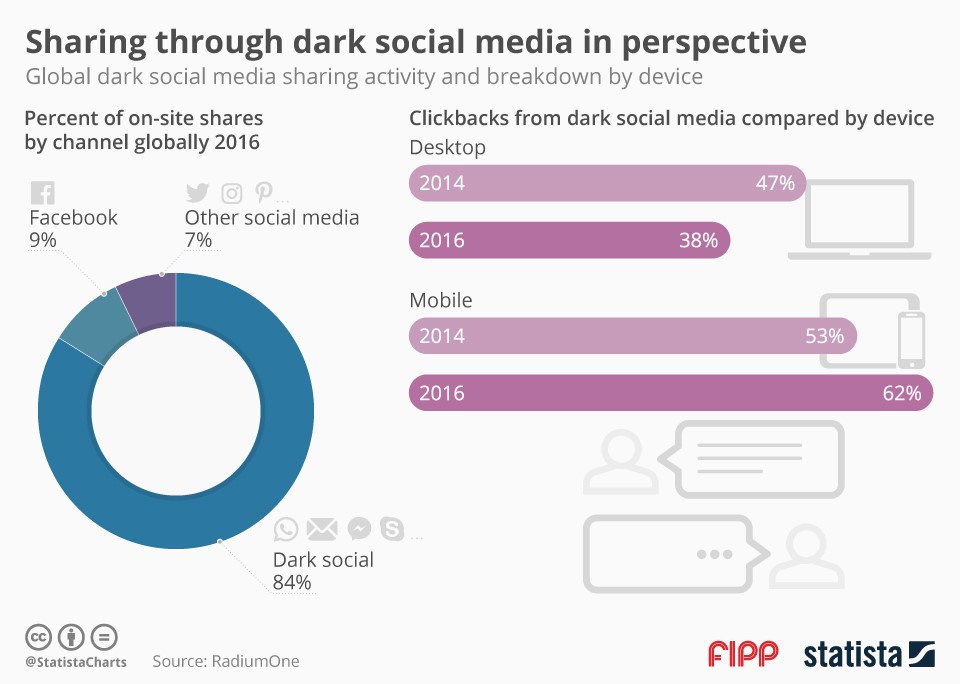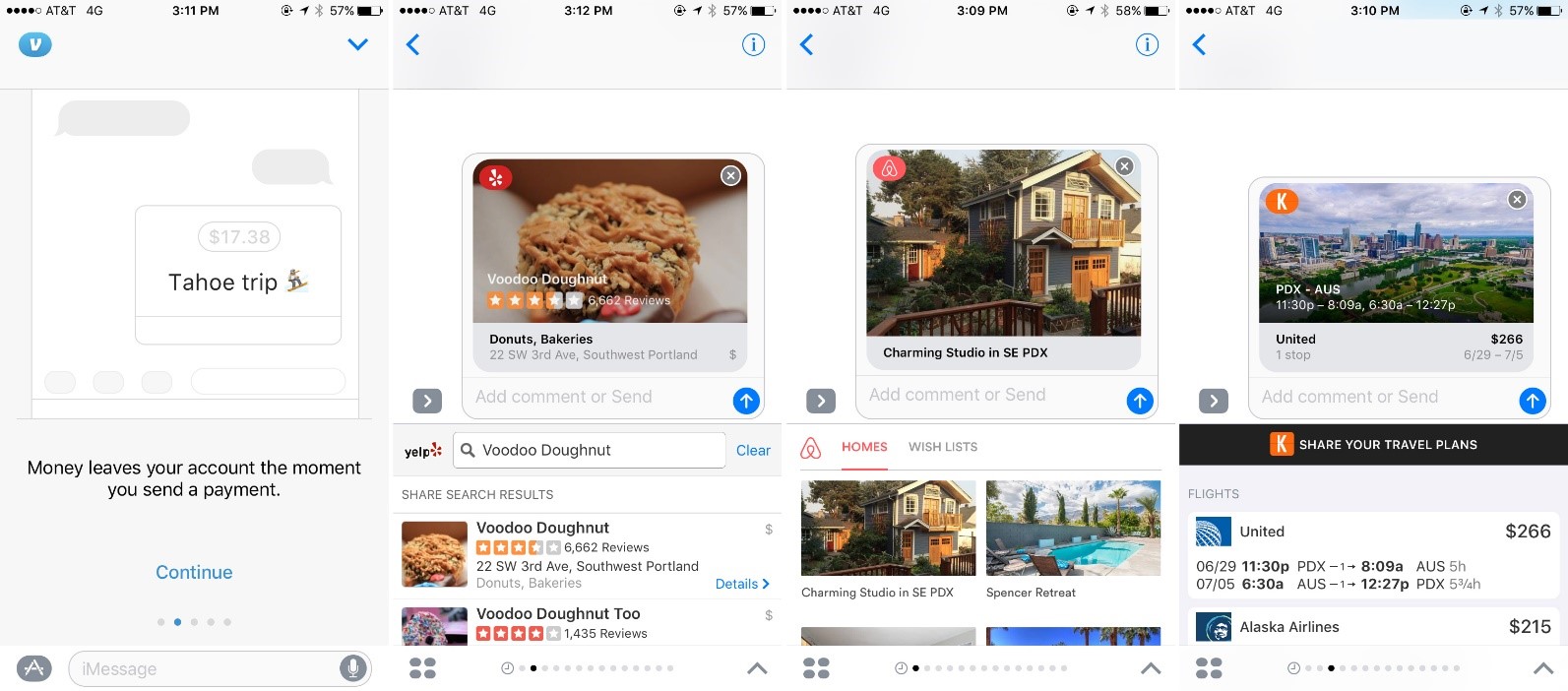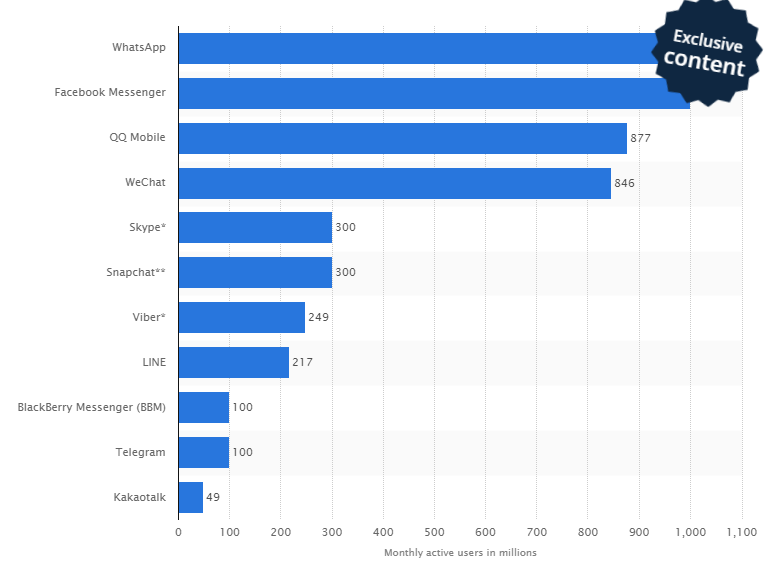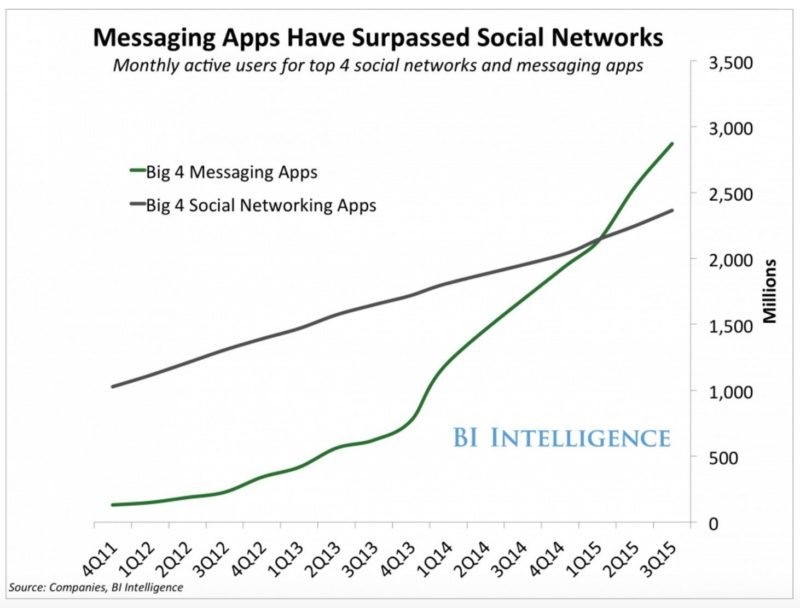
Remember the first text message you ever sent? Besides the 160 character limit, uncertain deliverability, and difficulty in keeping track of conversations, SMS used to be pricey. Carriers set a cap on messages sent and received per month, and would charge customers for each text that exceeded the limit.
At their inception, messaging apps were created to be a solution for this problem; WhatsApp, WeChat, Facebook Messenger, and others came into popularity as many people—especially those outside the U.S.—opted out of expensive SMS plans. But times have changed, and messaging apps have evolved. What began as a simple alternative for one-on-one communication has now become a go-to platform for sharing content, getting social, and interacting with both friends and brands. But before you can begin marketing on these platforms, you need to fully understand how and why they’re being used.
Are messaging apps really that popular?
The answer is a resounding “yes.” Take a look at this 2017 data set from Statista that chronicles the monthly active users, in millions, of the most popular messaging apps. WhatsApp and Facebook Messenger alone have over 1 billion users each, per month!
How are messaging apps being used?
People aren’t using messaging apps just to make plans with friends or talk about their day. Messaging apps are becoming a prime destination to share content, be it interesting articles, funny gifs, or cute stickers. In April of last year, Ash Read of Buffer shared their insights on how messaging apps are changing social media:
As we progress through 2016 and beyond, we’ll start to notice most social activity is no longer going to happen in public, instead transitioning to private groups and messaging apps. This represents a significant change in what “social media” is.
His prediction is warranted. When it comes to sharing content, “dark social”—like emails or messaging apps—accounts for a whopping 84% of on-site shares.

This makes sense when you consider why you would share a piece of content in the first place. If you want to discuss a great article on trends in your industry, you’re probably going to share it with your coworkers over email or Slack. If you want to talk about this year’s Oscar’s nominees, maybe you’ll start a group chat on Facebook Messenger or WhatsApp.
The key point here is that messaging apps are the ideal channel for personalized engagement. Newsfeeds are saturated. If you want a sustained discussion on politics or pop culture, you’re more likely going to get a response through a direct message to your friends than through hoping your tweet gets some engagement.
And make no mistake—this is a trend that’s here to stay. Business Insider released data in September 2016 confirming that messaging apps have become more popular than social networks in terms of monthly usage.
Don’t worry, social media usage is still increasing steadily! But this sharp spike in the popularity of messaging apps is incredibly noteworthy.
Is iMessage considered a messaging app too?
iMessage is a unique platform. It’s exclusive to iPhone users, so it’s not technically a messaging app that can be downloaded in a store, and it’s also used interchangeably with SMS texting. If you’re texting a friend who also has an iPhone, chances are you are iMessaging them (as indicated by blue text bubbles). Within the same app, however, you can also SMS non-iPhone users (as indicated by green text bubbles).
But the most recent iOS 10 update indicates that Apple is trying stay relevant and compete in the messaging apps sphere. While iMessage had much of the same personalization and functionality as other messaging apps, iOS 10 allowed users to get even more wildly animated with their messages, like adding jazzy text effects, balloons, confetti, lasers, and more. They also gave users greater flexibility in how they communicate, much like competing messaging apps: you can send gifs, you can group message, you can share stickers or Bitmoji.
Most importantly though, the iOS 10 update was the first time iMessage started to created room for brands.

Apps like Venmo, Yelp, AirBnB, and Kayak are now integrated directly in iMessage. So, you can pay back a friend, recommend a restaurant, book accommodations for your next trip, or share flight information without ever leaving the platform. This external app integration is likely just the first step in how brands can reach users on iMessage. Because of this, iMessage is a platform marketers should look out for.
WeChat, Viber, Line… Why haven’t I heard of so many of these platforms?
Many messaging apps have a much larger international presence than they do in the U.S. WeChat is the number one messaging app used in China. Line is huge in Japan. Viber is the most popular in the Philippines and Vietnam. While WhatsApp’s mobile penetration in the U.S. in 2014 was only about 8%, it was the number one mobile app in places like India, Spain, and South Africa.
Why is this the case? To better understand the role of messaging apps on a global scale, let’s take a look at some history. The rise of these messaging apps is a phenomenon that Hubspot discusses in detail here. Here’s a breakdown of what happened:
1. Pew Research releases data that U.S. Cell phone users, particularly 18-24 year olds, send 50-100 text messages per day. This is a large number, and one that signified that phone calls were no longer a preferred method of communication.
2. U.S. cellular carriers accommodate for the popularity of texting by releasing unlimited texting plans. However, many carriers in countries outside the U.S.— like China, Japan, and Mexico—do not.
3. Messaging Apps like WhatsApp, WeChat, Line, and Viber become a widely used alternative among these international audiences that didn’t have access to unlimited texting.
4. Apple’s iOS 5 update introduces iMessage in 2011, a messaging app platform exclusive to iPhone users that functions similar to SMS, but can be used over the internet without affecting SMS rates and at no additional cost.
5. Mark Zuckerberg launches Facebook Messenger as a standalone messaging app in 2011. While this seemed like an arbitrary distinction for many Facebook users, his goal was to have Messenger become a self-sufficient platform. Today, you don’t even need a Facebook account to use Messenger.
6. Messaging apps become popular worldwide
Okay, so messaging apps are popular. How do I factor them into my social media strategy?
In his guide to messaging apps, Ash Read of Buffer posed the following question: “Until now, standing out in the timelines and News Feeds typified by Facebook and Twitter have been the primary goal of most social media strategies. But what about when these feeds are no longer the first place people turn for discovery and interaction?”
Some marketers have already recognized the need to meet users on these private, direct channels, and the most popular method so far has been through the use of chatbots. Many big brands today are using these artificially intelligent bots to provide real time service to customers. After Facebook launched Bots for Messenger back in April 2016, chatbots became integral to many retail holiday campaigns by the end of the year. Retailers like Everlane used their bots to report on shipping times; Mastercard created a bot that helps you check your balance; H&M used bots to provide gift recommendations.
Thinking of incorporating messaging apps into your social media strategy? We can help with that.





Sorry, the comment form is closed at this time.